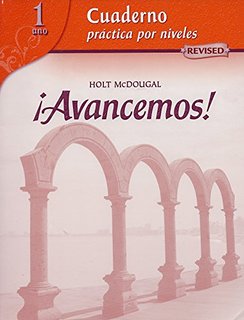
All Solutions
Page 375: Gramatica C
– *este/esta/esto – this* and *estos/estas – these* to refer to things that are **near (cerca)**
– *ese/esa/eso – that* and *esos/esas – those* to refer to things that are **far (lejos)**
– *aquel/aquella/aquello – that over there* and aquellos/aquellas – those over there* to refer to things that are **very far (muy lejos)**
**N.B.** Remember that demonstration adjectives match with the noun in number and gender.
– …**estos** aretes de plata.
*(I bought these silver earrings.)*
*”Aretes”* is a masculine noun in plural, so the demonstrative adjective has *”-os*” at the end.
*”Estos”* implies the souvenirs are near.
– …**aquellos** collares que tú quires.
*(My friends saw those necklaces that you want.)*
*”Collares”* is a masculine noun in plural, therefore, the demonstrative adjective has *”-os*” at the end.
*”Aquellos”* means that the necklaces are very far.
– …**esos** recuerdos muy baratos.
*(You bought those really cheap souvenirs.)*
*”Recuerdos”* is a masculine noun in plural, therefore, the demonstrative adjective has *”-os*” at the end.
*”Esos”* implies the souvenirs are far.
– …**esas** artesanías muy bonitas.
*(I saw those really nice handicrafts.)*
*”Artesanías”* is a feminine noun in plural, so the demonstrative adjective has *”-as*” at the end.
*”Esas”* means that the handicrafts are far.
– …**esta** joya de oro.
*(You bought this golden piece of jewelry.)*
*”Joya”* is a feminine noun in singular, so the demonstrative adjective has *”-a*” at the end.
*”Esta”* means that the piece of jewelry is near.
1. estos
2. aquellos
3. esos
4. esas
5. esta
**N.B.** Remember that demonstration adjectives match with the noun in number and gender.
*”Este”* means we need a singular masculine noun that is near. So, the sentence could be:
– Yo vi **este** hombre en el supermercado.
*(I saw this man at the supermarket.)*
*”Aquellas”* means we need a plural feminine noun that is very far. So, the sentence could be:
– Mi hermana me compro **aquellas** joyas que queria.
*(My sister bought me those pieces of jewelry that I wanted.)*
*”Esos”* means we need to use a masculine noun in plural that is far.
– **Esos** libros son muy pesados.
*(Those books are very heavy.)*
*”Esa*” means we need to use a feminine noun in the singular that is far.
– ¿Te acuerdas de **esa** blusa que viste ayer?
*(Do you remember that blouse you s aw yesterday?)*
*”Estos”* means we need a plural masculine noun that is near. So, the sentence could be:
– Me encantan **estos** zapatos.
*(I love these shoes.)*
Use either:
– *este/esta/esto – this* and *estos/estas – these* to refer to things that are near (cerca)
– *ese/esa/eso – that* and *esos/esas – those* to refer to things that are far (lejos)
**N.B.** Remember that demonstration adjectives match with the noun in number and gender.
*(How pretty are these photos.)*
*”Fotos”* is a feminine noun in plural, so we used the demonstrative adjective *”estas,”* which also implies the photos are near.
*(We have to read all those books.)*
*”Libros”* is a masculine noun in plural, so we used the demonstrative adjective *”esos,”* which also implies the books are far.
*(This hamburger is very tasty.)*
*”Hamburguesa”* is a feminine noun in singular, so we used the demonstrative adjective *”esta,”* which implies the hamburger is near.

